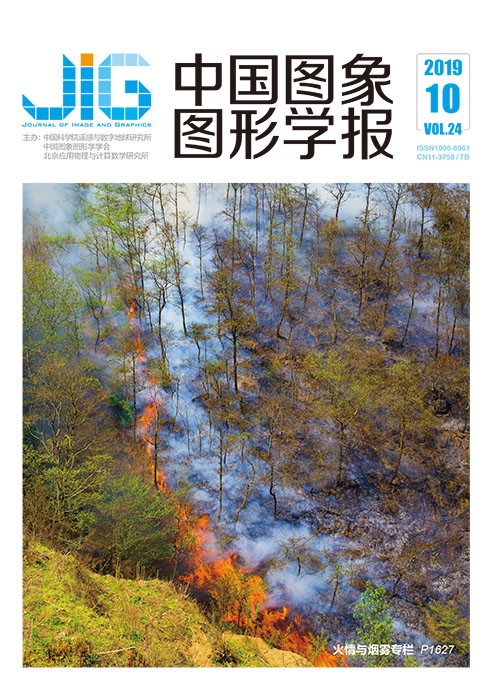
融合随机森林模型的布料分层建模
摘 要
目的 在布料仿真中,针对基于物理方法计算复杂、耗时长、实时性差的缺点,提出了一种融合随机森林模型的布料分层建模方法。方法 采用基于物理的方法计算出各个质点的初始位置,连接各个质点形成最初始水平布料。然后通过使用随机森林模型的回归算法来推断质点在下一水平布料的位置,使用3细分法连接质点,再通过边翻转操作生成稳定的布料网格,重复上述过程直至产生满意的动画效果。结果 在固定共轭梯度法(CG)改进后的隐式积分方法和交替方向乘子法(ADMM)的迭代次数,保证两种传统方法计算的模拟结果具有相似误差的情况下,实验结果表明,当模拟的质点数较少时,融合随机森林模型的布料分层建模方法与两种传统基于物理的模拟方法相比,没有很大的优势,但在模拟足够数量的质点时,融合随机森林模型的布料分层建模方法的模拟速度相比于ADMM算法提高了约26%。结论 采用随机森林模型来进行分层布料模拟,省去了传统基于物理的模拟方法进行的大量数值计算,显著提升了布料模拟的效率,并且在施加外界力、与外界物体发生碰撞的情况下,融合随机森林模型的布料分层建模方法依旧可以产生稳定可靠的模拟动画,是一种高效的布料模拟方法。
关键词
Fabric layered modeling based on random forest algorithm
Jin Yanxia, Zhang Jinrui, Cheng Qifu, Qi Xin, Jia Yao, Ma Bo(School of Big Data, North University of China, Taiyuan 030051, China) Abstract
Objective Cloth simulation has a long history of research and is important in the fields of physical simulation, computer games, virtual reality, etc. With the continuous development of computer software and hardware technology, virtual simulation has become a research hotspot in the field of computer graphics. As a classic flexible object, cloth can be seen everywhere in people's lives. Effectively and realistically simulating the movement of fabrics (such as flags, curtains, tablecloths, etc.) on a computer remains challenging and needs to be solved. Realistic virtual human costume animation can bring a strong visual reality to virtual characters and has broad application prospects in cultural creative fields, such as animation, game entertainment, film and television. In addition, the method can be applied to the apparel industry for virtual clothing design and display. In recent years, with the emergence of applications, such as virtual reality and human-computer interaction, especially the rise of network virtual environments with high user-interaction characteristics, the demand for real-time virtual human costume animations, such as online games and distributed collaborative design environments, has increased. Neural network models are used to train the data and improve the simulation rate of fabrics for multi-precision cloth division threshold according to the degree of deformation of different regions, rather than manual threshold division, during the cloth simulation. However, the traditional physics-based method is still used to calculate the particle position in cloth simulation. Physics-based simulation methods are computationally complex, time consuming, and perform poorly in real time. Although considerable research has been conducted to improve physics-based methods, such as the recent alternating direction method of multipliers (ADMM) algorithm, further improvements can be made. This paper proposes a layered simulation of cloth based on the random forest model, instead of the physics-based simulation method. Method We present fabric layered modeling method based on random forest algorithm, and its working principle is as follows. The initial levels of fabric are simulated using traditional physics-based methods. Implicit integration method is used to calculate the initial position of each particle in the initial horizontal fabric. The index value of the triangle generated by the above steps is recorded as 0. High levels of fabric are then simulated using the random forest model. The random forest algorithm is applied to predict the position of each particle in the initial horizontal fabric in a higher level of fabric. One is added to the index value of the newly generated triangle in the above step. This article uses the √3 subdivision method to divide the mesh fabric; as such, edge flip operation should be performed to eliminate the narrow triangle. When the triangle generated in the above step has a triangle that shares the edge with the edge corresponding to the obtuse angle in the triangle and the two triangles have the same index value, the edge flip operation is performed. One is added to the index value of the new triangle generated by the edge flip operation. Whether the cloth animation generated at this time can meet the demand is determined. If the requirements are met, then the simulation is terminated. If the requirements are not met, then steps 2 to 4 are repeated until satisfactory animation is produced. Result The capacity of the regression tree in the random forest model is the lowest when the simulation takes the lowest time. The number of iterations of fixed conjugate gradient method and alternating direction method of multiplier algorithm ensures that the simulation results by the two traditional methods have similar deviation. When the number of simulated particles is small, the random forest-based layered cloth simulation method has no significant advantage compared with the two traditional physics-based simulation methods. However, when simulating a sufficient number of particles, the simulation speed of the layered cloth simulation method based on the random forest model is about 26% higher than that of the ADMM algorithm. To verify whether the method can produce stable and reliable simulation results, we add wind force in the experiment. Random sampling is carried out to ensure that the experimental results are representative. The method can still produce stable and reliable cloth animation effects under the influence of external force. Conclusion This paper proposes a fabric layered modeling method based on the random forest algorithm. The fabric is hierarchically simulated by replacing the traditional physics-based integration method with a random forest algorithm. The random forest algorithm is used to predict the position of the particle in the next horizontal cloth, and the edge flip operation is used to generate a stable and reliable triangular mesh cloth. The feasibility and effectiveness of the stratified fabric simulation method based on random forest are verified from multiple evaluation indicators relative to the two traditional physics-based fabric simulation methods.
Keywords
cloth simulation multi-resolution cloth hierarchical cloth simulation machine learning random forest
|



 中国图象图形学报 │ 京ICP备05080539号-4 │ 本系统由
中国图象图形学报 │ 京ICP备05080539号-4 │ 本系统由